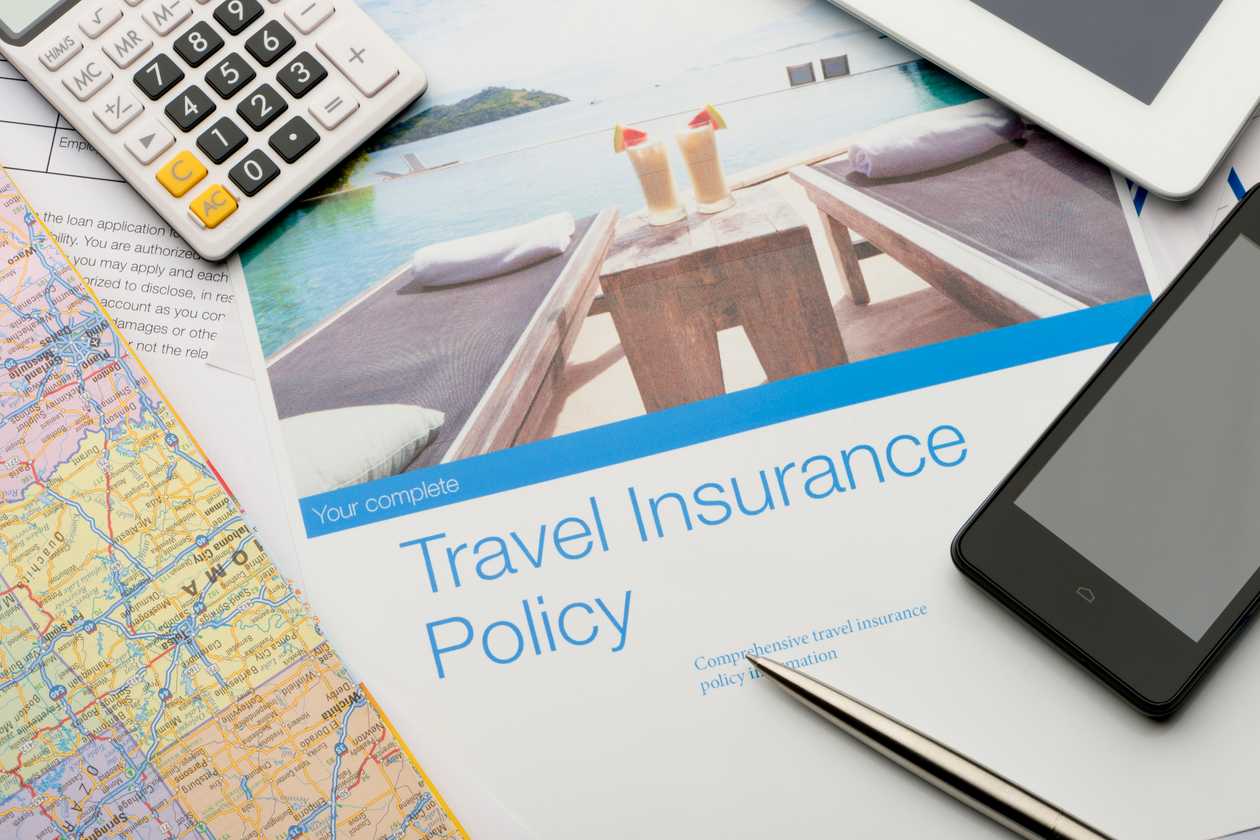Our evaluations and opinions are not influenced by our advertising relationships, but we may earn a commission from our partners’ links. This content is created independently from TIME’s editorial staff. Learn more about it.
Travel insurance can cover financial losses due to unforeseen setbacks both before you depart and during a trip. These include trip cancellation, travel delays and interruption, medical emergencies, medical evacuations, and loss of luggage. In general, travel insurance policies are good for U.S. and international travel and usually cost between 4% to 8% of the total trip price.

Travelex Travel Insurance
Travelex Travel Insurance
Policy cancellation
How does travel insurance work?
Travel insurance works in the same manner as other kinds of insurance policies, such as plans to protect a home, car, or other valuable assets like jewelry. Travel insurance plans protect certain prepaid, nonrefundable, trip-related costs that could be at risk in the case of an unexpected issue. Among them: a delayed flight that causes you to miss a cruise, an injury that causes your trip to be cut short, or an airline losing your luggage.
Should you get travel insurance?
The decision to purchase a travel insurance plan is closely connected to the traveler’s risk tolerance, the value of their trip, and the potential for certain circumstances to arise that could cause disruptions to their travel plans, says Rhonda Sloan, head of marketing and travel industry relations at AIG Travel.
“For example, a cruise that cost $15,000 would be an investment that many would consider worth protecting, particularly if there could be issues that put prepaid, nonrefundable trip costs at risk,” says Sloan. “For more expensive trips or those that take a traveler farther from home, a travel insurance plan might be on their radar, as the chances of lost luggage, canceled or delayed flights, injuries related to trip activities, or other travel mishaps are greater.”
Travel insurance types
Most travel insurance plans include some coverage for trip cancellation, trip interruption, trip delay, medical expenses, emergency medical evacuation, and lost luggage. AIG Travel, for example, offers three levels of its basic travel insurance plans for standalone trips—Deluxe, Preferred and Essential— that provide varying levels of coverage limits. Also, travel insurers offer optional travel insurance plan upgrades, known as “bundles,” that augment your policy with customized travel insurance plan packages tailored to your specific travel needs.
One of the most popular reasons people buy travel insurance is for trip cancellation coverage, which is a pre-departure benefit. Emergencies can happen before a scheduled trip, and your travel insurance policy will provide a list of acceptable reasons that are covered by your plan. It’s important to thoroughly read your travel insurance documents.
If the reason you’re canceling is covered under your policy, you can file a claim to receive 100% of the prepaid, nonrefundable trip deposits you would lose because you aren’t going on your trip. Typical reasons that will be covered by your trip cancellation benefits include: death, illness, or injury to you, a travel companion, or a close family member; a serious family emergency; severe weather; a sudden job loss; unplanned jury duty; your travel supplier going out of business; a national transportation strike; and a national emergency.
Not all reasons will be covered by a basic travel insurance policy. For example, fear of travel or having a fight with your travel companion before a trip are not reimbursable reasons to cancel.
If you want the highest level of flexibility regarding your travel plans, consider adding “cancel for any reason” coverage to your basic travel insurance plan. This add-on will boost your travel policy price by about 50%, but it will allow you the latitude to cancel for any reason, so long as you do so no later than 48 hours before your scheduled departure. If you meet all the criteria, you can expect to recover between 50% to 75% of your nonrefundable, prepaid trip outlays.
How do you choose the best insurance policy?
There is no one-size-fits-all when it comes to travel insurance. It’s up to the individual to review each policy type and determine if the benefits included fit their personal needs and concerns, says Daniel Durazo, director of external communications at Allianz Partners U.S. “How much insurance you need comes down to how much you’re willing to risk losing in the event of an unexpected cancellation or emergency situation,” he adds.”
It’s also advisable to research policy options and your destination. “Do your homework,” says Sloan. She explains that it is important for travelers to have a good understanding of their destination and the mishaps that might be common there: severe weather, petty crime, etc. “Travelers should also carefully review the details of any insurance plan they are considering to learn about coverage amounts, potential coverage exclusions, and optional policy upgrades,” says Sloan.
Aim to get an understanding of plan and coverage options, as well as the likelihood for certain mishaps at a planned destination, so you’re in a better position to choose a travel insurance plan that’s best suited for your trip.
What is covered by a standard travel insurance policy?
Most standard travel insurance policies are going to include some coverage for trip cancellation, trip interruption, trip delay, travel medical expenses, emergency medical evacuation, and benefits for lost or stolen baggage and some personal effects.
What is not covered by travel insurance?
Policy exclusions will vary by carrier and plan, so be sure to read your plan documents to understand all the exclusions and limitations.
Sloan says that travel insurance plans generally do not cover losses caused by—or resulting from—such situations as acts of war, epidemics or pandemics, travel restrictions imposed by government authorities, foreseeable events, or fear of travel.
The following items are also generally not covered by travel insurance.
- Pre-existing conditions. Although travel insurance is an excellent safeguard against many types of medical emergencies abroad—from accidents to evacuations—most policies have built-in exclusions for pre-existing conditions, says Stan Sandberg, cofounder of TravelInsurance.com. “If you’ve been seriously ill in the past or need ongoing treatment, consider looking for a plan that offers a pre-existing condition waiver,” he says.
- Luggage in limbo. Coverage for lost luggage is common, but it usually doesn’t kick in until your bags have been missing for a set number of hours. Check your policy for waiting times, says Sandberg. “In case of a delay, it’s a good idea to carry a least a day’s worth of medication, toiletries, and clothing in your carry-on.”
- When trip cancellation rules don’t apply. As mentioned, not all reasons to receive benefits under your starter travel insurance plan will apply. “Generally, coverage extends to situations that are out of your control, including death in the family, natural disasters, unexpected work obligations, new illnesses, and injuries. In other words, you won’t be able to get your money back if you simply change your mind,” says Sandberg.
- Pregnancy and childbirth. Standard pregnancy-care expenses incurred while away won't be covered by a travel insurance plan, even if you hold a pre-existing condition waiver. Prenatal services such as routine care, ultrasounds, and medical expenses for labor and uncomplicated childbirth won’t be covered by travel insurance. The best course of planning is to speak with your medical provider to decide if travel is advisable during pregnancy. Some emergency pregnancy-related expenses may be covered by travel insurance. Also, you may be able to get special coverage for pregnancy as an add-on.
How much does travel insurance cost?
As noted above, travel insurance policies for U.S. and international travel usually cost between 4% to 8% of the total trip price.
What affects travel insurance costs?
As an example, AIG Travel’s Deluxe, Preferred, and Essential travel insurance plans are priced based on:
- Traveler’s age.
- Trip cost.
- Trip duration.
- State of residence.
How can you get travel insurance?
You can purchase travel insurance through:
- Carrier. You can buy directly from a travel insurance carrier online and answer prompts to get a quote and make a purchase. You can also call the company’s toll-free number and speak with a representative. In addition, travel advisors also offer travel insurance plans.
- Credit card. Some credit cards have travel insurance benefits, but this coverage will vary, so it’s best to check with your specific credit card issuer. There are often exclusions and limitations, so request an overview of the scope of the policy. Another important factor is that you must pay for your entire trip on the card on which you plan to file a claim.
How can you get the most out of travel insurance?
- Purchase your travel insurance plan as soon as you book your trip and take advantage of all the pre-departure benefits, such as trip-cancellation coverage.
- Look into a waiver of the exclusion for pre-existing medical conditions.
- Take advantage of all the perks included. For example, there should be travel-assistance services if you experience a travel disruption, such as a delayed flight or lost luggage. Most carriers have a 24/7 hotline that provides free help, including concierge services, translation services, and medical referrals.
What are the key travel insurance trends for 2023?
According to a report released in 2022 by Allianz the top trends are:
- Elevated levels of demand for travel insurance.
- How increased economic and geopolitical volatility are affecting travel insurance.
- Higher customer expectations regarding travel insurance and the claims process.
TIME Stamp: Travel insurance provides a valuable safety net
The nominal cost of a policy, which spans from 4% to 8 % of your trip costs, can save you thousands of dollars if you need to cancel your trip due to a covered reason in your policy, experience travel delays or interruptions, become ill or injured while away, or have your baggage or personal belongings lost or stolen while traveling.
There are also upgrades that can be purchased, such as “cancel for any reason” coverage and sports and medical bundle upgrades to starter insurance plans. Ultimately, travel insurance provides peace of mind and can protect your trip investment, health, and belongings.
Virtually all travel insurance carriers have an 800 number where representatives can answer questions. Their websites also provide very thorough descriptions of travel insurance plans to select.
Frequently asked questions (FAQs)
What are the top travel destinations for 2023?
Based on TravelInsurance.com customer data, popular destinations for 2023 include Italy, Mexico, the United Kingdom, Jamaica, Canada, France, Ireland, Germany, the Bahamas, and Greece.
Does travel insurance get more expensive closer to the trip?
Generally, the price won’t get higher as your trip approaches. For instance, Sloan says that AIG Travel’s Deluxe, Preferred, and Essential travel insurance plans do not change in price when purchased closer to the departure date. “However, purchasing early relative to the initial deposit date has its advantages, such as a waiver of the pre-existing medical conditions exclusion,” she says.
Do I need car rental insurance when I travel outside of the United States?
Personal auto insurance policies in the U.S. may not provide coverage if you’re renting a car abroad. “Some countries require certain minimum coverage amounts or types of coverage for a vehicle rental insurance policy, so be sure to check the specifics of the country you’ll be driving in,” says Sloan.
The information presented here is created independently from the TIME editorial staff. To learn more, see our About page.

